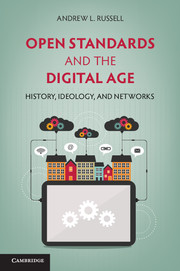Book contents
- Frontmatter
- Dedication
- Contents
- Tables and Figures
- Acknowledgments
- List of acronyms
- 1 Introduction
- 2 Ideological Origins of Open Standards I: Telegraph and Engineering Standards, 1860s–1900s
- 3 Ideological Origins of Open Standards II: American Standards, 1910s–1930s
- 4 Standardization and the Monopoly Bell System, 1880s–1930s
- 5 Critiques of Centralized Control, 1930s–1970s
- 6 International Standards for the Convergence of Computers and Communications, 1960s–1970s
- 7 Open Systems and the Limits of Democratic Design, 1970s–1980s
- 8 The Internet and the Advantages of Autocratic Design, 1970s–1990s
- 9 Conclusion
- Bibliography
- Index
- References
1 - Introduction
Published online by Cambridge University Press: 05 June 2014
- Frontmatter
- Dedication
- Contents
- Tables and Figures
- Acknowledgments
- List of acronyms
- 1 Introduction
- 2 Ideological Origins of Open Standards I: Telegraph and Engineering Standards, 1860s–1900s
- 3 Ideological Origins of Open Standards II: American Standards, 1910s–1930s
- 4 Standardization and the Monopoly Bell System, 1880s–1930s
- 5 Critiques of Centralized Control, 1930s–1970s
- 6 International Standards for the Convergence of Computers and Communications, 1960s–1970s
- 7 Open Systems and the Limits of Democratic Design, 1970s–1980s
- 8 The Internet and the Advantages of Autocratic Design, 1970s–1990s
- 9 Conclusion
- Bibliography
- Index
- References
Summary
The architects of the twenty-first-century digital age proclaim that openness is their foundational value. Their work is exemplified in movements that embrace open science, open access publishing, open source software, open innovation business strategies, open education, and so on. President Barack Obama’s “Open Government Initiative,” announced on his first day in office in 2009, captured the collective spirit of these efforts: “We will work together to ensure the public trust and establish a system of transparency, public participation, and collaboration. Openness will strengthen our democracy and promote efficiency and effectiveness in government.”
The ideology of openness, as it is articulated and practiced in the early twenty-first century, would have surprised the critic and historian of technology Lewis Mumford. In his 1964 essay, “Authoritarian and Democratic Technics,” he wondered: “Why has our age surrendered so easily to the controllers, the manipulators, the conditioners of an authoritarian technics?” The advocates of openness, however, have not surrendered so easily. Instead, they sense the dawn of a radical, almost utopian transformation in which power hierarchies are flattened, secret activities are made transparent, individuals are empowered, and knowledge itself is democratized. They welcome innovation, thrive on diversity and change, insist on the sanctity of autonomy and freedom, and have an unqualified disdain for authority, restrictions, and gatekeepers.
- Type
- Chapter
- Information
- Open Standards and the Digital AgeHistory, Ideology, and Networks, pp. 1 - 24Publisher: Cambridge University PressPrint publication year: 2014
References
- 1
- Cited by



